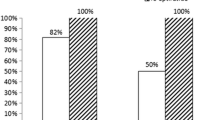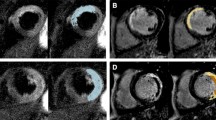Abstract
Introduction
Percutaneous coronary intervention (PCI) does not often produce optimal results, despite restoration of coronary blood flow at myocardial recovery, because of impaired microvascular perfusion. This study aimed to investigate and evaluate with 99mTc-sestamibi scan whether the results of PCI can be changed by maintenance infusion of tirofiban for 24 or 48 h in patients presenting with anterior ST-elevation myocardial infarction (STEMI).
Methods
The study included 84 patients with anterior STEMI who were candidates for primary PCI and whose occlusion was in the proximal or mid-left anterior descending artery. Patients were given 25 μg/kg/3 min tirofiban and randomized to receive maintenance infusion at 0.15 μg/kg/min for 24 or 48 h. A resting 99mTc sestamibi scan was performed on the 5th day post-procedure before discharge. The primary efficacy endpoint was a patient’s score on a 5-point scoring system for perfusion defect severity. Major adverse cardiac events (MACE) were defined as death from any cause, re-infarction, and clinically driven target-vessel revascularization within the first 6 months.
Results
Baseline characteristics of the patients were similar in the two infusion groups (n = 42 per group). There was no significant difference in the symptom onset-to-presentation time or door-to-balloon time between the two groups. With the exception of basal anteroseptal and basal anterior segments, significant reductions were obtained on the 5-point scoring system for perfusion defect severity in segments and in the summed rest scores. No significant differences were observed between the two groups in the incidence of MACE at 6 months. The safety profile did not differ between 24 and 48 h infusions of tirofiban.
Conclusion
The use of tirofiban, when administered at a high bolus dose and maintained for 48 h, was safe and significantly reduced perfusion defect severity in patients with anterior STEMI presenting early after symptom onset and undergoing primary PCI.


Similar content being viewed by others
References
Falk E. Coronary thrombosis: pathogenesis and clinical manifestations. Am J Cardiol. 1991;68:28B–35B.
Andersen HR, Nielsen TT, Rasmussen K, et al. A comparison of coronary angioplasty with fibrinolytic therapy in acute myocardial infarction. N Engl J Med. 2003;349:733–42.
Stenestrand U, Lindbäck J, Wallentin L, RIKS-HIA Registry. Long-term outcome of primary percutaneous coronary intervention vs prehospital and in-hospital thrombolysis for patients with ST-elevation myocardial infarction. JAMA. 2006;296:1749–56.
O’Gara PT, Kushner FG, Ascheim DD, et al. 2013 ACCF/AHA guideline for the management of ST-elevation myocardial infarction: a report of the American College of Cardiology Foundation/American Heart Association Task Force on Practice Guidelines. American College of Emergency Physicians; Society for Cardiovascular Angiography and Interventions. J Am Coll Cardiol. 2013;61:e78–140.
Brener SJ, Cristea E, Mehran R, Dressler O, Lansky AJ, Stone GW. Relationship between angiographic dynamic and densitometric assessment of myocardial reperfusion and survival in patients with acute myocardial infarction treated with primary percutaneous coronary intervention: the harmonizing outcomes with revascularization and stents in AMI (HORIZONS-AMI) trial. Am Heart J. 2011;162:1044–51.
Stone GW, Maehara A, Witzenbichler B, et al. Intracoronary abciximab and aspiration thrombectomy in patients with large anterior myocardial infarction: the INFUSE-AMI randomized trial. JAMA. 2012;307:1817–26.
Gibbons RJ, Christian TF, Hopfenspirger M, Hodge DO, Bailey KR. Myocardium at risk and infarct size after thrombolytic therapy for acute myocardial infarction: implications for the design of randomized trials of acute intervention. J Am Coll Cardiol. 1994;24:616–23.
Gibbons RJ, Miller TD, Christian TF. Infarct size measured by single photon emission computed tomographic imaging with (99m)Tc-sestamibi: a measure of the efficacy of therapy in acute myocardial infarction. Circulation. 2000;101:101–8.
Lang SH, Manning N, Armstrong N, et al. Treatment with tirofiban for acute coronary syndrome (ACS): a systematic review and network analysis. Curr Med Res Opin. 2012;28:351–70.
Valgimigli M, Campo G, Percoco G, et al. Comparison of angioplasty with infusion of tirofiban or abciximab and with implantation of sirolimus-eluting or uncoated stents for acute myocardial infarction: the MULTISTRATEGY randomized trial. JAMA. 2008;299:1788–99.
Van’t Hof AW, Ten Berg J, Heestermans T, et al. Prehospital initiation of tirofiban in patients with ST-elevation myocardial infarction undergoing primary angioplasty (On-TIME 2): a multicentre, double-blind, randomised controlled trial. Lancet. 2008;372:537–46.
Balghith MA. High bolus tirofiban vs abciximab in acute STEMI patients undergoing primary PCI—the Tamip Study. Heart Views. 2012;13:85–90.
Pereztol-Valdés O, Candell-Riera J, Santana-Boado C, et al. Correspondence between left ventricular 17 myocardial segments and coronary arteries. Eur Heart J. 2005;26:2637–43.
Carlsson M, Hedeer F, Engblom H, Arheden H. Head-to-head comparison of a 2-day myocardial perfusion gated SPECT protocol and cardiac magnetic resonance late gadolinium enhancement for the detection of myocardial infarction. J Nucl Cardiol. 2013 Jul 10 (Epub ahead of print).
Berman DS, Hachamovitch R, Kiat H, et al. Incremental value of prognostic testing in patients with known or suspected ischemic heart disease: a basis for optimal utilization of exercise technetium-99m sestamibi myocardial perfusion single photon emission computed tomography. J Am Coll Cardiol. 1995;26:639–47.
Zijlstra F, de Boer MJ, Hoorntje JC, Reiffers S, Reiber JH, Suryapranata H. A comparison of immediate coronary angioplasty with intravenous streptokinase in acute myocardial infarction. N Engl J Med. 1993;328:680–4.
Lee KL, Woodlief LH, Topol EJ, et al. Predictors of 30-day mortality in the era of reperfusion for acute myocardial infarction: results from international trial of 41,021 patients. GUSTO-I Investigators. Circulation. 1995;91:1659–68.
Martínez-Ríos MA, Rosas M, González H, et al. Comparison of reperfusion regimens with or without tirofiban in ST-elevation acute myocardial infarction. Am J Cardiol. 2004;93:280–7.
Gersh BJ, Stone GW, White HD, Holmes DR Jr. Pharmacological facilitation of primary percutaneous coronary intervention for acute myocardial infarction: is the slope of the curve the shape of the future? JAMA. 2005;293:979–86.
The RESTORE Investigators. Effects of platelet glycoprotein IIb/IIIa blockade with tirofiban on adverse cardiac events in patients with unstable angina or acute myocardial infarction undergoing coronary angioplasty. Circulation. 1997;96:1445–53.
Liu X, Tao GZ. Effects of tirofiban on the reperfusion-related no-reflow in rats with acute myocardial infarction. J Geriatr Cardiol. 2013;10:52–8.
Heestermans AA, Hermanides RS, Gosselink AT, et al. A comparison between upfront high-dose tirofiban versus provisional use in the real-world of non-selected STEMI patients undergoing primary PCI: insights from the Zwolle acute myocardial infarction registry. Neth Heart J. 2010;18:592–7.
Schneider DJ, Herrmann HC, Lakkis N, et al. Increased concentrations of tirofiban in blood and their correlation with inhibition of platelet aggregation after greater bolus doses of tirofiban. Am J Cardiol. 2003;91:334–6.
Batchelor WB, Tolleson TR, Huang Y, et al. Randomized COMparison of platelet inhibition with abciximab, tiRofiban and eptifibatide during percutaneous coronary intervention in acute coronary syndromes: the COMPARE trial. Comparison of Measurements of Platelet aggregation with Aggrastat, Reopro, and Eptifibatide. Circulation. 2002;106:1470–6.
Ibrahim T, Bulow HP, Hackl T, et al. Diagnostic value of contrast-enhanced magnetic resonance imaging and single-photon emission computed tomography for detection of myocardial necrosis early after acute myocardial infarction. J Am Coll Cardiol. 2007;49:208–16.
Wagner A, Mahrholdt H, Holly TA, et al. Contrast-enhanced MRI and routine single photon emission computed tomography (SPECT) perfusion imaging for detection of subendocardial myocardial infarcts: an imaging study. Lancet. 2003;361:374–9.
Onishi T, Kobayashi I, Onishi Y, et al. Evaluating microvascular obstruction after acute myocardial infarction using cardiac magnetic resonance imaging and 201-thallium and 99m-technetium pyrophosphate scintigraphy. Circ J. 2010;74:2633–40.
Acknowledgments
The authors would like to thank Atatürk University Rectorate and Chiesi Pharmaceutical Company employees, Tufan Yildirim and Oguz Ozturk, for their helpful discussions. No funding or sponsorship was received for this study or publication of this article.
Conflict of interest
M. Hakan Tas, Ziya Simsek, Arif Ayan, Ugur Aksu, Selami Demirelli, Yavuzer Koza, Zakir Lazoglu, Bedri Seven, and Huseyin Senocak declare that they have no conflict of interest. Dr. Tas is the guarantor for this article, and takes responsibility for the integrity of the work as a whole.
Compliance with ethics guidelines
The study was approved by the local ethical committee of the Atatürk University (B.30.2ATA.0.01.00/3). All procedures followed were in accordance with the ethical standards of the responsible committee on human experimentation (institutional and national) and with the Helsinki Declaration of 1975, as revised in 2000. Informed consent was obtained from all patients for being included in the study.
Author information
Authors and Affiliations
Corresponding author
Rights and permissions
About this article
Cite this article
Tas, M.H., Simsek, Z., Ayan, A. et al. Effects of Tirofiban Maintenance Duration on Myocardial Perfusion Defect Severity in Anterior Myocardial Infarction. Adv Ther 30, 834–844 (2013). https://doi.org/10.1007/s12325-013-0055-y
Received:
Published:
Issue Date:
DOI: https://doi.org/10.1007/s12325-013-0055-y




